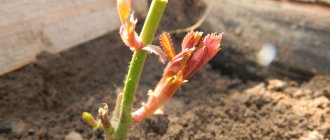Rose Charlotte - what kind of variety is it?
D. Austin developed it in 1993. And already in 1994, the rose was presented to flower growers under the registration name AUSpoly. The rose received its name Charlotte in honor of one of his beloved granddaughters.
For your information! Often on the Internet you can find such erroneous names as “Charlotte rose” or “Charlotte rose”. It is necessary to understand that the discussion on the forum or in the article is about this particular variety from a famous English breeder.
What does Charlotte look like?
The crosses used varieties such as Conrad Ferdinand Meyer and Chaucer, as well as pollen from the Graham Thomas rose. The rose received its external characteristics from the Graham Thomas variety, but there are still differences from it.
Short description
The bush is a compact, erect, branched, dense bush reaching 180 cm (in warm regions it can be 2 m) in height, up to 150 cm wide. The leaves are dark green, glossy. The shape of the bush is spherical.
Flower buds reach up to 11 cm in diameter. The flower may have up to 100 slightly wavy petals, which form dense, double inflorescences. Their shape changes from the moment of formation until the rose fully opens. If the bud is initially pointed-round in shape, then at the moment the flower blooms it becomes hemispherical.
For your information! The unopened flower has a bright yellow color. When in full bloom it becomes a honey yellow hue. Moreover, the outer petals have a paler color. Rose buds can bloom either singly or in groups of 3-5. in one brush.
Advantages and disadvantages of the variety
Many gardeners choose this variety because it is winter-hardy compared to the same Graham Thomas rose. Withstands bad weather very well. It has a pleasant aroma that attracts insects. The plant is highly branched, the bush itself is neat and compact. Its soft yellow flowers are an immediate eye-catcher.
But Charlotte's rose also has significant disadvantages:
- often suffers from powdery mildew and black spot;
- flowers fall off quite quickly;
- the buds fade from exposure to sunlight.
Use in landscape design
The English rose Charlotte is so beautiful that you can find a place for it on any site, even if its area is small. Whatever style is chosen for the garden, it will not be difficult to fit a plant into it. Classic, modern, country or any other stylistic direction can be chosen for the garden and these roses can be planted. Therefore, it is planted not only in the country house or garden plot, but also in park areas.
Rose Austin Charlotte
Brief description, characteristics
Lady Emma Hamilton rose was bred more than 10 years ago. Now it has gained great popularity because of its beauty and original smell, as well as its ease of care. The rose was named after Admiral Nelson's beloved woman. Several years after the Lady Emma Hamilton variety appeared, it was introduced to America, where it aroused the interest of flower growers and won many awards for its wonderful scent.
Variety bred by David Austin
The bushes reach a height of 100-150 cm with incredible colors of flowers, miniature, branched, with straight stems. In appearance, the rose resembles a large flowering ball. Bronze-colored leaves set off large flowers well, later becoming a rich green color.
Unopened buds are characterized by a burgundy color interspersed with orange. The inner part of the petals of the culture has an orange tint. The outer one is yellow or pink. There is a pronounced fruity aroma, where the smells of grapes, orange and pear are mixed.
Important! The plant is a representative of the English variety. It blooms throughout the summer, is resistant to frost, but has a negative attitude towards precipitation. In very rainy summers, the buds may not bloom
In very rainy summers, the buds may not bloom.
Lady E. Hamilton and Admiral Nelson
Growing a flower
When planting Charlotte in a permanent place in open ground, you must follow the rules for growing it so that there are no problems with flowering in the future.
In what form is planting carried out?
Rose Red Naomi - description of the Dutch variety
Planting in open ground is done with seedlings. You should choose plants that have three healthy shoots. The root system should be developed, and white flexible roots should be visible on the cut.
Important! Successful cultivation of Charlotte roses is guaranteed only when the planting material was purchased from a specialized store or nursery. The rose standard must be at least 90 cm. Only then can you be sure that the seedling has retained all the varietal characteristics of the plant, and its further cultivation will not bring additional trouble.
Before planting in open ground, the roots of the seedling should be soaked in water, to which growth stimulants such as kornevin or heteroauxin are added. Soaking is carried out for 4-5 hours. This helps the plant adapt more easily, and the shoots of the ornamental shrub will begin to develop more actively.
What time does boarding take place?
In central Russia, it is preferable to plant a Charlotte bush rose seedling in open ground in the spring. The best period is considered to be from April to May. Planting in the fall is also acceptable, but it is worth considering that the plant needs time to take root, otherwise the rose seedling will not have enough strength to survive the winter. If this happens, the bush will be sick for a long time, which will affect its flowering.
Step by step landing procedure
Be sure to adhere to the following process for planting a seedling:
- A hole is dug at least 50 cm deep and 60 cm in diameter.
- A pre-prepared substrate is added: 2 parts fertile soil, 1 part peat, 1 part sand, 1 part humus, 1 glass of wood ash, 300 g of fertilizer for roses.
- They form a small mound in the center of the hole and carefully place the rose on it so that the grafting site is a couple of centimeters below the surface.
- Then the soil around the plant is compacted and watered with sufficient water.
- The surface should be mulched so that the soil does not dry out and the roots do not overheat.
Note! The planting site should be well ventilated, but in winter the plant should be protected from cold winds. Groundwater should not lie too close, otherwise the English Charlotte rose will suffer from black spot.
Plant care
Rose JP Connell - description of the yellow variety
Caring for a rose is a labor-intensive procedure, but it is worth it. For its proper growth, it is not enough just to plant the seedling in the ground. The plant requires regular watering, loosening, and fertilizing. Only then will the Charlotte rose begin to grow, and its first flowers will soon appear.
Charlotte of England
Watering and humidity
Watering Charlotte roses is carried out if the soil dries out by 3-5 cm. One bush will need up to 10 liters of warm water. It is necessary to ensure that watering is not carried out along the bush, but only at the root. You should irrigate the rose once a week; if the weather is hot, then you should reduce the interval. In hot weather, you can spray roses, but only in the evening. Watering is also done only in the evening.
Important! You should periodically loosen the soil and always mulch it afterwards. This helps to better saturate the rose roots with oxygen.
Fertilizing and soil quality
In the first year, rose Charlotte will receive enough nutrients from the substrate that was placed in the planting hole. In the spring of the second year, you should first add humus. After two weeks, fertilize with nitrogen fertilizer, and the plant is also watered with a solution of chicken manure or mullein. You can replace them with ammonium nitrate.
When the formation of rose buds begins and its active flowering begins, for 2-3 weeks you should water the bushes with fertilizer, which contains a sufficient amount of potassium, phosphorus and magnesium. In the first half of September, the last fertilizing with potassium sulfate is carried out.
Important! Root feeding stops at the end of August so that the rose bush stops producing new shoots and has enough time to prepare for winter.
As for the quality of the soil, this should be taken care of even before planting the Charlotte rose in the ground. The soil should be fertile, light, breathable. If the soil is heavy clay, it is worth adding sand, peat, humus, and compost. Sandy soil needs the addition of clay soil, into which peat-manure compost or humus is mixed. Soil acidification is carried out by adding peat or manure, and to reduce acidity - ash or lime. A reaction favorable for Austin rose should be slightly acidic.
Pruning and replanting
In order for the Austin Charlotte rose to bloom profusely, periodic pruning is done to form a beautiful bush. This is necessary not only for the rose to rejuvenate, but also to increase winter hardiness and greater resistance to various diseases.
Note! To trim the bush, you should use only sharp pruning shears. A blunt instrument will injure the bark, which will lead to infection of the rose and further development of diseases. It is necessary to disinfect the tool after each pruning, otherwise the risk of spreading disease increases if one of the bushes is already infected.
Charlotte rose bush
The first pruning is carried out in April, when the buds have not yet bloomed. To keep the bush compact, the shoots are cut in half. To make the bush grow tall, shorten them by one third. In summer, during flowering, pruning removes wilted, small, blind shoots, as well as those that show signs of disease or pests. In the fall, unripe shoots and leaves are removed, and the remaining stems are cut to 30 cm. Pruning aimed at rejuvenating the Charlotte rose bush is carried out once every 5 years. The bush is either trimmed completely to a height of 25 cm, or old shoots are removed.
Features of wintering a flower
For winter, Rose Charlotte must be covered as soon as the temperature drops below −7 °C. But before this, the bush is pruned, and its base is covered with garden soil, humus or compost.
Important! Sand, peat and sawdust retain moisture, so they do not need to be used.
Spruce spruce branches are excellent as a covering material, which is placed between and on top of plants. Then a frame is installed from any suitable material, which should rise 30 cm above the bushes. Insulation is laid on the frame itself, and then plastic film. Also, do not forget to leave side holes for ventilation. With the onset of spring, the bushes are ventilated, but only the film is removed. The insulation can be removed a little later.
Organization of wintering
English roses are resistant to winter cold, but I cannot winter without shelter in severe frosts, and the Charlotte variety is no exception. Winter shelter consists of hilling the base to a height of 25-30 centimeters and constructing a warm canopy over the bush from spruce branches and covering material.
Hilling is carried out when cold weather sets in. Before the first frost. A hut made of spruce branches and a dry house made of covering material are installed above the rose when frosts occur below 10 degrees.
How to plant a rose correctly - black magic. Rose Double Delight is a two-color and fragrant beauty, see in detail at the link https://cveti-rasteniya.ru/roza-dabl-delajt-opisanie-foto-posadka.html
Rose blossom
According to the description, the Charlotte rose blooms with very beautiful yellow flowers. Its flowering will not leave anyone indifferent. Many gardeners, once seeing a bush in full bloom, decide to purchase seedlings of this variety of roses and plant them on their site.
Period of activity and rest
Rose Mainzer Fastnacht - description of the variety
The Charlotte rose blooms throughout the summer, but the buds are the most lush in June and July. From mid-July to September the plant does not bloom so profusely.
Care during and after flowering
In the first year, young plants should not be allowed to bloom profusely. Before August, all buds from the plant should be removed. At the end of summer, a couple of flowers are left on each shoot so that they have time to ripen before autumn. This contributes to better wintering of roses, and they will bloom more abundantly next year.
Important! More mature plants need regular watering, fertilizing, and loosening the soil. Also, after heavy and frequent rains, you should shake the bush slightly so that excess moisture does not stagnate on its buds. In the fall, after flowering has stopped, routine autumn pruning and leaf removal are carried out, as well as further preparation for the upcoming winter period.
What to do if it doesn't bloom
A rose may stop blooming or may not produce buds at all for many reasons.
- Growing in the wrong place. English rose Charlotte thrives in partial shade. If there is too much sunlight, its flowers may fade and fall off quickly. If there is not enough of it at all, the rose becomes frail, which adversely affects its flowering.
- Over or under pruning. It is necessary to remove excess shoots correctly and at the right time. In spring - moderate pruning, in summer - to stimulate flowering, in autumn - sanitary pruning. Once every 5 years the bush should be rejuvenated. In summer, faded buds are systematically removed.
English rose Charlotte
- Incorrect care. Rose requires special care. If you water it on time and not enough, do not fertilize it and do not spray it against pests, it immediately reacts to this by the absence of lush flowering.
History of creation
Pat Austin is a representative of the English selection. She was created in the family nursery David Austin Roses Limited. This delightful variety was bred by David Austin and named in honor of his beloved wife Pat Austin, a very talented and gifted woman. It is her sculptures that occupy key places in the David Austin Rose Garden, located in Albright. This wonderful park annually attracts a lot of tourists who come to admire the collection of 800 types of beautiful flowers of various colors. To create the future masterpiece, the breeder used well-known varieties as parents - the large-flowered Abraham Darby and the deep yellow Graham Thomas. In 1993, our heroine was selected from the samples received. In 1995, a magnificent new product was introduced in the UK as the Pat Austin. The registration name consists of the original letter code and sounds like AUSmum. In 1996, a patent for breeding a new variety was received in Canada, Europe and the USA. In 1999, the lovely Englishwoman was introduced to Australia.
Flower propagation
Roses can only be propagated by cuttings. No other method is suitable for her. This is the only way to ensure that the plant has the same varietal characteristics.
Note! Rose Charlotte is propagated by cuttings, which in turn must be taken from strong, young bushes, immediately after the first wave of flowering has passed.
The cutting process occurs as follows:
- To obtain propagation material, you should take a semi-lignified shoot and cut a stalk, the length of which should be 10-12 cm.
- Then they are deepened in the garden bed, but not completely. Part of it must remain on the surface.
- A transparent cap must be placed on top. Cut plastic bottles are great for this.
- Cuttings can be planted after three years in a permanent place.
Diseases, pests and ways to combat them
Most often, Austin's rose Charlotte suffers from the following ailments:
- downy mildew. To combat the disease, zinc-containing fungicides are used;
- gray rot. To treat flowering shrubs, use copper sulfate or the drug foundationazole;
- cancer. As soon as the first signs of this disease appear, you should cut off the affected areas, then treat the roots with copper sulfate. The affected parts on the stems are removed, burned, and healthy areas are treated with zinc sulfate;
- rust. Treatment is carried out by spraying with topsin-M, SKOR or treated with potassium nitrate.
If the Charlotte rose is affected by aphids, the best solution is the drug alatar. The roseate leaf roller is afraid of systemic insecticides, the spider mite is afraid of soap solution and the drug Actellik.
Rose Charlotte, planted on the site, will be an excellent decoration for any garden. It is beautiful both in a single planting and in a group composition. The main thing is to plant the seedling correctly and provide it with decent care.











